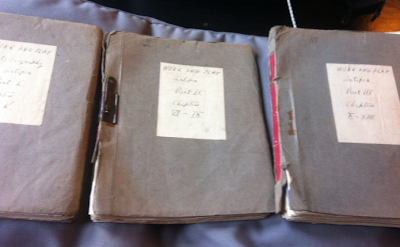"But people say, and say with some reason that it (Handicraft) neither makes useful things nor makes them particularly attractive; and this, they say, is because all useful things are made by machines and all pretty things by professional artists. This is a disheartening criticism more often inferred than expressed, and is the more dangerous because, in a way, it has almost become a truth. The things we use are, as a matter of fact, almost invariably made by machines; the things we admire, pictures, poems, plays, are the work of a profession of artists. We have come to believe that this is a satisfactory, or at any rate an inevitable, state of things. It has a scientifically complete look about it, as if we had struck the bed-rock and arrived at a workable hypothesis about these matters; and yet it is just this complacent formula, this glib hypothesis, that we must deny and reject, for it has never yet been entirely true and, pray God, may never become so.
 |
| Godfrey Blount from W.R.Trotter, The Hilltop Writers, The Book Guild Ltd, 2003 |
"Useful things never used to be made by machines till machines were invented to make them; pretty things were never made for the public by a profession solely devoted to aesthetics, till the ordinary artisan had given up making them instinctively himself. The flaw that lies at the bottom of this formula, however, and which contaminates and retards the revival of Handicraft, is that useful things and pretty things have nothing necessarily to do with each other; and the first law of any real revival and lasting renaissance of Handwork, as opposed to machine work, is that such a distinction should cease to exist, and that a really useful thing must be considered a pretty one, and a thing which has no real use must be considered an ugly one.
"Those of us who are in earnest, including perhaps a few politicians, are beginning to see that this country can only be saved, physically, mentally, and spiritually, by cultivating it. Soon we shall also realise that if a return to the land is the correct cure for overcrowding in the towns, the object of cultivating the land will not be the feeding of towns but starving them, and the feeding of the new peasantry; and that only so far as the towns are making useful things, useful, that is to say, to the countryman, will the countryman consent to support the towns.
 |
| Surrey Landscape by Godfrey Blount Bushey Museum & Art Gallery |
"It is a question entirely of where you will have your population, in the country or in the town. You cannot have it in both, healthily, at the same tie, and the mistake people make is, that when they talk and think about the future, they don't seem able to see that these huge festers of manufacturing cities are quite unnecessary to the nation's true welfare or happiness, and persist in imagining that the agricultural revival will be perpetual saddled with the weight of them.
"A return to the country must imply the decay of the town. If it does not imply this it can be no true return. A return to the country with the corresponding decline of the town, must also mean a return to simplicity and Handicraft, because, when the town ceases to be a burden on the countryman's back, he will have to make what he wants by hand in the country instead of having them made by machinery in the town.
"But, above all, a return to the country means the determination to be thorough-bred peasants and not mongrel ones. What we are most of us secretly hoping may happen is to be able to play at peasants, like Marie Antoinette, and live in garden cities that will combine all the advantages of town and country life, with the disadvantages of neither. Garden cities may be capital investments and convenient suburbs for people with hobbies and for week-end visitors; but no solution for the danger that has us by the throat, and which is eating our heart out. The rural depopulation is our punishment, call it misfortune if you like, the city is our sin. No national revival or revivification is possible, till we repent of our sin and return with some sort of conviction to the manners, if not to the faith, of our forefathers."
 |
| Sunset over the Downs by Godfrey Blount Bushey Museum & Art Gallery |














